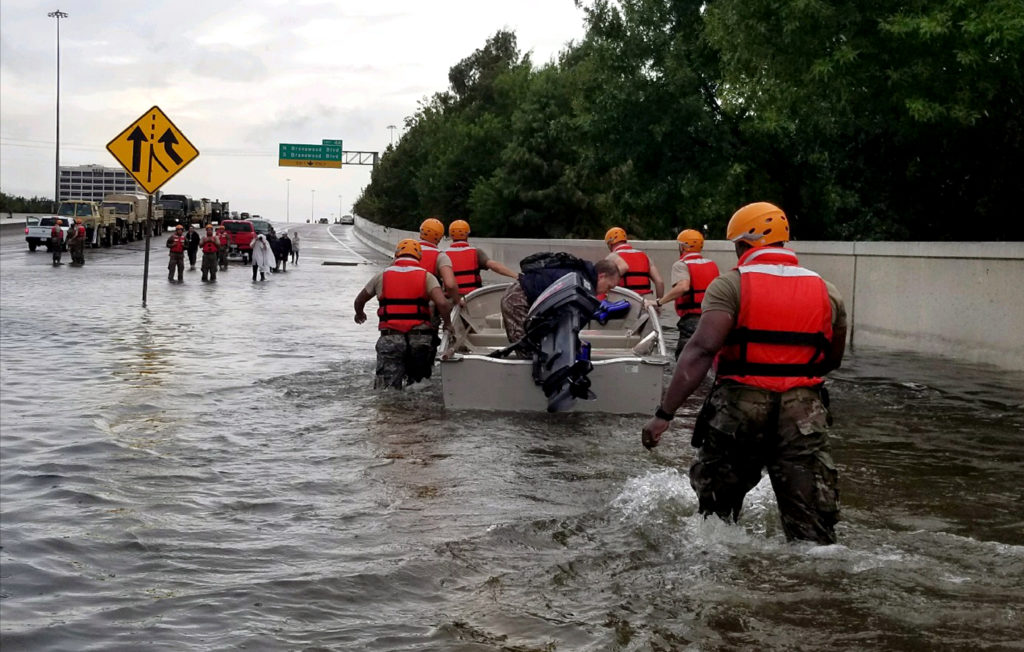September has offered a sobering glimpse of the growing frequency and intensity of extreme weather patterns and their horrifying impacts. Record breaking heat, storms, and floods are being described with a growing collection of superlatives: hottest, wettest, most, and worst.

As research scientist Katharine Hayhoe explains, as the world warms, more rapid evaporation increases the amount of water vapor that a storm absorbs and then releases as compared to storms of 70 years ago. The result: Hurricane Harvey, a storm system that barreled up the Texas coast and within hours grew in intensity from category 2 to category 4 and ultimately unloaded an estimated 33 trillion gallons of water along the Gulf of Mexico. The sudden deluge in this single storm dropped rainfall that exceeded the annual average for the region by eight feet. And barely two weeks after Harvey’s landfall, Hurricane Irma, one of the most powerful hurricanes ever recorded in the history of Atlantic Ocean hurricanes, now threatens to be equally if not more destructive than Harvey. The category 5 system moved with winds in excess of 185 mph towards the Caribbean Islands on its way to Florida. Experts have predicted that the storm’s impact could bring a path of destruction to the islands that will leave residents without critical infrastructure for months.
While Harvey survivors were being rescued by boat from waist high flooding in the Gulf of Mexico, parts of South Asia including India, Bangladesh, and Nepal were hit with the worst monsoon rains in years. Flood waters submerged roads, weakened and collapsed buildings, and have killed thousands. On the African continent, the cities of Lagos and Ajua in Nigeria have similarly suffered heavy local rainfall. Earlier this year, the release of excess water from the Lagdo Dam in Cameroon flooded streets, and just days ago, torrential rainfalls in Makkurdi, Bennue State washed away homes, destroyed property, and left thousands of residents homeless. Scientists anticipate that what were once rare one hundred-year storms will now happen with greater frequency and intensity.
Increasing global temperatures also produce dry, hot conditions that can also be devastating. Record temperatures in the western United States have produced unprecedented heat waves, where some cities are seeing triple digit temperatures for the first time in recorded history. In Los Angeles, California, extreme heat has fueled the largest wildfires ever recorded within city limits. The raging fires began early in April and have scorched millions of acres of land in the first six months of 2017 and have exceed the annual average of acres burned during the 1980’s. The thick haze of wildfire smoke contains hundreds of toxic compounds that reduce air quality and keeps thousands of young children, the elderly, and others who are vulnerable to respiratory and heart conditions indoors or in hospitals.
These tangible impacts of climate change, regardless of the city, disproportionately impact the sick, the poor, the disabled, and communities of color. It is heartbreaking to witness so much suffering around the world. It is stunning to comprehend the billions in damages to property that was destroyed so quickly and displaced so many so suddenly. And it is infuriating to read the peer reviewed science released this week building on research that attributes historical greenhouse gas emissions to a small group of Carbon Majors (or the 90 biggest oil, gas, and coal companies) to establish a peer reviewed methodology to attribute the impacts of climate change to those actors.
The study, published in Climatic Change by researchers from the Union of Concerned Scientists, Climate Accountability Institute, and Oxford University, demonstrates that specific climate impacts – from increases in global temperature to sea level rise to deaths from extreme heat waves – can now be directly attributed to a small and very specific group of companies. As CIEL’s own research documents, many of these companies have been aware of climate risks for more than half a century, yet continued to engage in active campaigns of climate denial and deception.
As Oxford University ethicist Professor Henry Shue notes in an accompanying essay, moreover, this is not simply willful inaction, but harmful and morally culpable conduct:
“At the start of the Industrial Revolution, very few people understood that carbon dioxide emissions progressively undermine the stability of the climate as they accumulate in the atmosphere, so there was nothing blameworthy about selling fossil fuels to those who wanted to buy them. But circumstances have changed radically [since the Industrial Revolution] in light of evidence that a number of investor-owned companies have long understood the harm of their products, yet carried out a decades-long campaign to sow doubts about those harms in order to ensure fossil fuels would remain central to global energy production. Companies knowingly violated the most basic moral principle of ‘do no harm, and now they must remedy the harm they caused by paying damages and their proportion of adaptation costs.”
More importantly, the UCS/CAI report is relevant not only to carbon producers’ ethical duties but to their legal responsibilities – and potential liabilities. The impacts of climate change are no longer remote, speculative, or uncertain. The UCS/CAI study demonstrates that the data, analysis, and technology available is more accurate than ever in linking corporate activity to the devastating consequences of climate change. Coupled with our Smoke & Fumes research and the work of others demonstrating just how early these companies knew their products could have this effect, government investigators and private attorneys around the world will be parsing these findings carefully.
These impacts of climate change must be mitigated now to avoid the catastrophic suffering and fatalities that scientists anticipate. Unrelenting and extreme weather events are part of the new normal for the global community. For all of us at CIEL, this present reality is a call to action – to fight for, to protect, and to defend the fundamental rights threatened by climate change, now more urgently now than ever before.
By Lisa Anne Hamilton
Originally posted September 10, 2017
